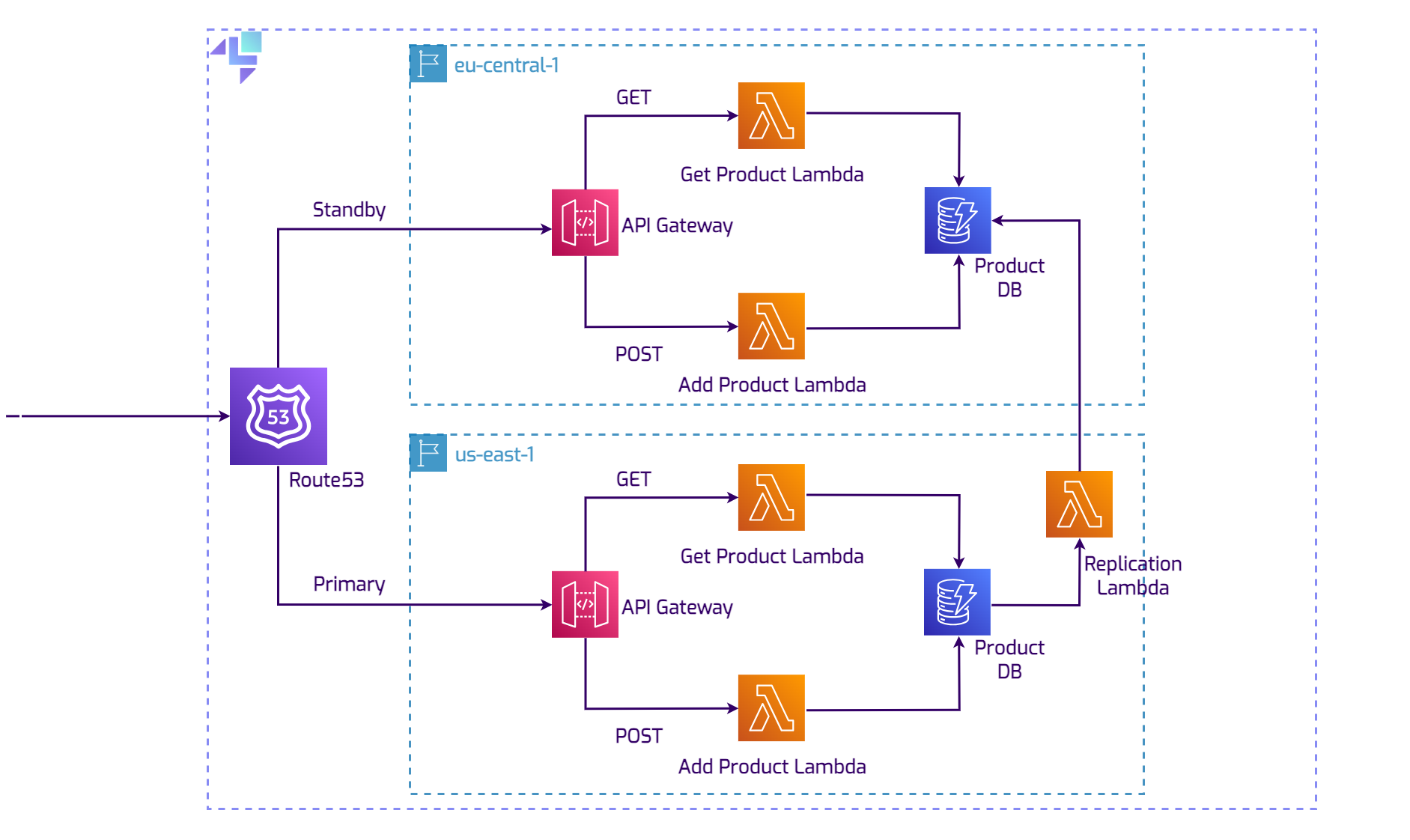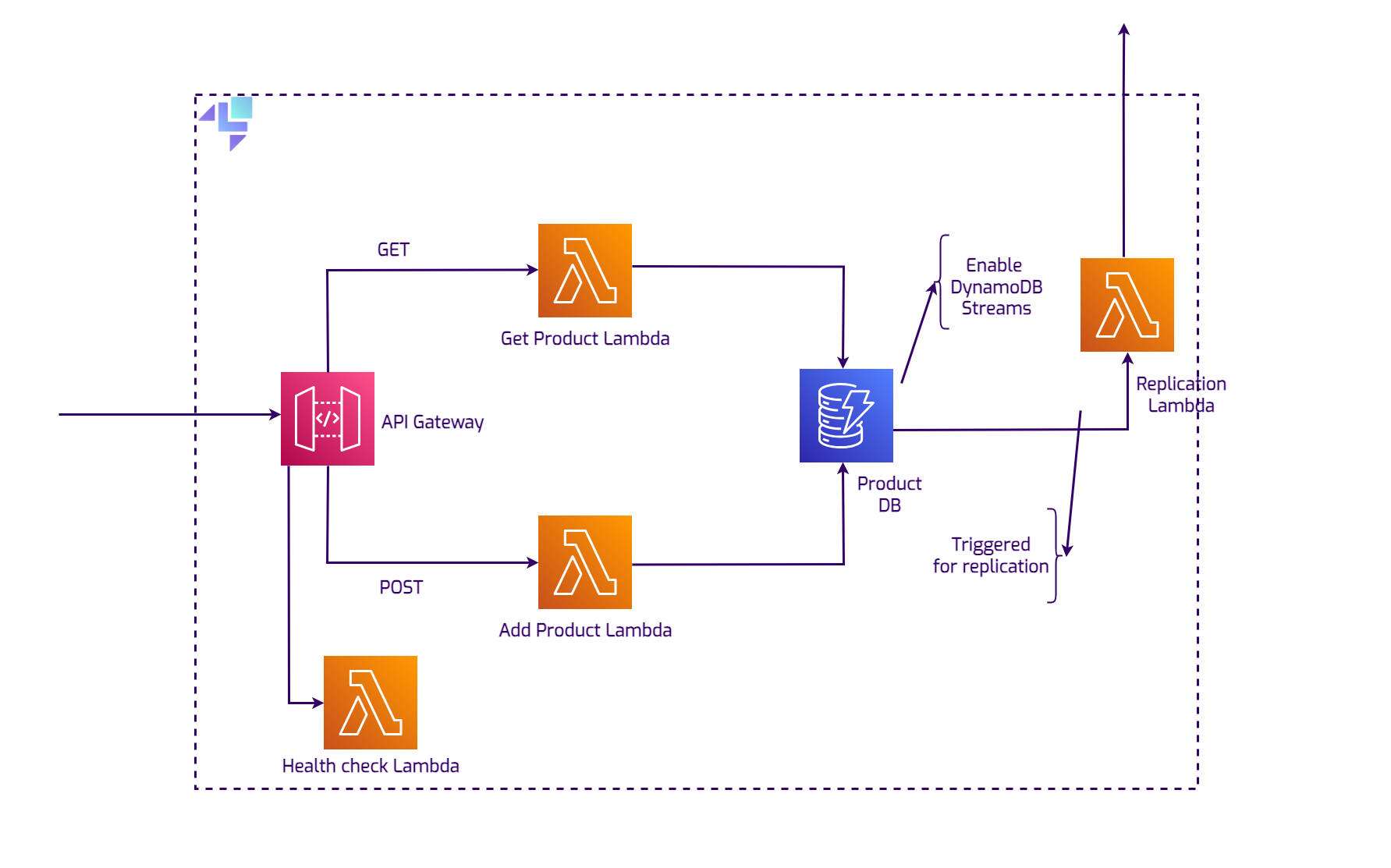Chaos Engineering: Route53 Failover with FIS
Introduction
LocalStack allows you to integrate & test Fault Injection Simulator (FIS) with Route53 to automatically divert users to a healthy secondary zone if the primary region fails, ensuring system availability and responsiveness. Route53’s health checks and traffic redirection enhance architecture resilience and ensure service continuity during regional outages, crucial for uninterrupted user experiences.
Note
Route53 Failover with FIS is currently available as part of the LocalStack Enterprise plan. If you’d like to try it out, please contact us to request access.Getting started
This tutorial is designed for users new to the Route53 and FIS services. In this example, there’s an active-primary and passive-standby configuration. Route53 routes traffic to the primary region, which processes product-related requests through API Gateway and Lambda functions, with data stored in DynamoDB. If the primary region fails, Route53 redirects to the standby region, maintained in sync by a replication Lambda function.
For this particular example, we’ll be using a sample application repository. Clone the repository, and follow the instructions below to get started.
Prerequisites
The general prerequisites for this guide are:
- LocalStack Pro with LocalStack Auth Token
- AWS CLI with the
awslocalwrapper - Docker and Docker Compose
- Python-3
dig
Start LocalStack by using the docker-compose.yml file from the repository. Ensure to set your Auth Token as an environment variable
during this process.
$ LOCALSTACK_AUTH_TOKEN=<YOUR_LOCALSTACK_AUTH_TOKEN>
$ docker compose upApplication Architecture
The following diagram shows the architecture that this application builds and deploys:

Creating the resources
To begin, deploy the same services in both us-west-1 and us-east-1 regions. The resources specified in the init-resources.sh
file will be created when the LocalStack container starts, using Initialization Hooks and the awslocal CLI tool.
The objective is to have a backup system in case of a regional outage in the primary availability zone (us-west-1). We’ll focus
on this region to examine the existing resilience mechanisms.

- The primary API Gateway includes a health check endpoint that returns a 200 HTTP status code, serving as a basic check for its availability.
- Data synchronization across regions can be achieved with AWS-native tools like DynamoDB Streams and AWS Lambda. Here, any changes to the primary table trigger a Lambda function, replicating these changes to a secondary table. This configuration is essential for high availability and disaster recovery.
Configuring a Route53 hosted zone
Let’s begin by setting up a hosted zone in Route53 named hello-localstack.com and retrieved the hosted zone ID:
$ HOSTED_ZONE_NAME=hello-localstack.com
$ HOSTED_ZONE_ID=$(awslocal route53 create-hosted-zone --name $HOSTED_ZONE_NAME --caller-reference foo | jq -r .HostedZone.Id)Then, define the health check ID for the API Gateway available in the us-west-1 region:
$ HEALTH_CHECK_ID=$(
awslocal route53 create-health-check \
--caller-reference foobar \
--health-check-config '{
"FullyQualifiedDomainName": "12345.execute-api.localhost.localstack.cloud",
"Port": 4566,
"ResourcePath": "/dev/healthcheck",
"Type": "HTTP",
"RequestInterval": 10
}' | jq -r .HealthCheck.Id
)This command creates a Route 53 health check for an HTTP endpoint (12345.execute-api.localhost.localstack.cloud:4566/dev/healthcheck)
with a 10-second request interval and captures the health check’s ID. The caller reference identifier in AWS resource creation or updates
prevents accidental duplication if requests are repeated.
To update DNS records in the specified Route53 hosted zone ($HOSTED_ZONE_ID), add two CNAME records: 12345.$HOSTED_ZONE_NAME
pointing to 12345.execute-api.localhost.localstack.cloud, and 67890.$HOSTED_ZONE_NAME pointing to 67890.execute-api.localhost.localstack.cloud.
Set a TTL (Time to Live) of 60 seconds for these records.
$ awslocal route53 change-resource-record-sets \
--hosted-zone $HOSTED_ZONE_ID \
--change-batch '{
"Changes": [
{
"Action": "CREATE",
"ResourceRecordSet": {
"Name": "12345.'$HOSTED_ZONE_NAME'",
"Type": "CNAME",
"TTL": 60,
"ResourceRecords": [
{"Value": "12345.execute-api.localhost.localstack.cloud"}
]
}
},
{
"Action": "CREATE",
"ResourceRecordSet": {
"Name": "67890.'$HOSTED_ZONE_NAME'",
"Type": "CNAME",
"TTL": 60,
"ResourceRecords": [
{"Value": "67890.execute-api.localhost.localstack.cloud"}
]
}
}
]
}'Finally, we’ll update the DNS records in the Route53 hosted zone identified by $HOSTED_ZONE_ID. We’re adding two CNAME records
for the subdomain test.$HOSTED_ZONE_NAME. The first record points to 12345.$HOSTED_ZONE_NAME and is linked with the earlier created
health check, designated as the primary failover target. The second record points to 67890.$HOSTED_ZONE_NAME and is set as the secondary
failover target.
$ awslocal route53 change-resource-record-sets \
--hosted-zone-id $HOSTED_ZONE_ID \
--change-batch '{
"Changes": [
{
"Action": "CREATE",
"ResourceRecordSet": {
"Name": "test.'$HOSTED_ZONE_NAME'",
"Type": "CNAME",
"SetIdentifier": "12345",
"AliasTarget": {
"HostedZoneId": "'$HOSTED_ZONE_ID'",
"DNSName": "12345.'$HOSTED_ZONE_NAME'",
"EvaluateTargetHealth": true
},
"HealthCheckId": "'$HEALTH_CHECK_ID'",
"Failover": "PRIMARY"
}
},
{
"Action": "CREATE",
"ResourceRecordSet": {
"Name": "test.'$HOSTED_ZONE_NAME'",
"Type": "CNAME",
"SetIdentifier": "67890",
"AliasTarget": {
"HostedZoneId": "'$HOSTED_ZONE_ID'",
"DNSName": "67890.'$HOSTED_ZONE_NAME'",
"EvaluateTargetHealth": true
},
"Failover": "SECONDARY"
}
}
]
}'This setup represents the basic failover configuration where traffic is redirected to different endpoints based on their health check
status. To confirm that the CNAME record for test.hello-localstack.com points to 12345.execute-api.localhost.localstack.cloud,
you can use the following dig command:
$ dig @localhost test.hello-localstack.com CNAME
.....
;; QUESTION SECTION:
;test.hello-localstack.com. IN CNAME
;; ANSWER SECTION:
test.hello-localstack.com. 300 IN CNAME 12345.execute-api.localhost.localstack.cloud.
.....
Creating a controlled outage
Our setup is now complete and ready for testing. To mimic a regional outage in the us-west-1 region, we’ll conduct an experiment that
halts all service invocations in this region, including the health check function. Once the primary region becomes non-functional,
Route 53’s health checks will fail. This failure will activate the failover policy, redirecting traffic to the corresponding services
in the secondary region, thus maintaining service continuity.
$ cat region-outage-experiment.json
{
"description": "template for internal server error for few regions i.e. us-west-1",
"actions": {
"regionUnavailable-us-west-1": {
"actionId": "localstack:generic:api-error",
"parameters": {
"region": "us-west-1",
"errorCode": "503"
}
}
},
"stopConditions": [],
"roleArn": "arn:aws:iam:000000000000:role/ExperimentRole"
}
This Fault Injection Simulator (FIS) experiment template is set up to mimic a Service Unavailable (503 error) in the us-west-1 region.
To create the experiment template, use the following command:
$ awslocal fis create-experiment-template --cli-input-json file://region-outage-experiment.jsonOnce the template is created, start the experiment using its ID:
$ awslocal fis start-experiment --experiment-template-id <EXPERIMENT_TEMPLATE_ID>
{
"experiment": {
"id": "651b5196-b244-4a8b-8ab6-d7b9e13998a0",
"experimentTemplateId": "d3a1a31b-c52e-49ec-8387-8f5eb75a11df",
"roleArn": "arn:aws:iam:000000000000:role/ExperimentRole",
"state": {
"status": "running"
},
"actions": {
"regionUnavailable-us-east-1": {
"actionId": "localstack:generic:api-error",
"parameters": {
"region": "us-west-1",
"errorCode": "503"
}
}
},
"stopConditions": [],
"creationTime": 1699902569.439826,
"startTime": 1699902569.439826
}
}
Replace <EXPERIMENT_TEMPLATE_ID> with the ID of the experiment template created in the previous step. When the experiment is active,
Route 53’s health checks will detect the failure and redirect traffic to the standby region as per the failover setup. Confirm this redirection with:
$ dig @localhost test.hello-localstack.com CNAME
.....
;; QUESTION SECTION:
;test.hello-localstack.com. IN CNAME
;; ANSWER SECTION:
test.hello-localstack.com. 300 IN CNAME 67890.execute-api.localhost.localstack.cloud.
.....
This indicates that the hosted zone name now points to the secondary API Gateway, and us-east-1 services are in use.
A Python script can simulate backend handling of this switch:
import dns.resolver
import requests
# Set the Route53 DNS resolver to use
dns_resolver_ip = '127.0.0.1'
# Domain to resolve
domain_to_resolve = 'test.hello-localstack.com'
# Resolve the CNAME record using the specified DNS server
resolver = dns.resolver.Resolver(configure=False)
resolver.nameservers = [dns_resolver_ip]
try:
cname_record = resolver.query(domain_to_resolve, rdtype=dns.rdatatype.CNAME)
resolved_domain = str(cname_record[0].target)
# Construct the full URL with the resolved domain
resolved_url = f'http://{resolved_domain}:4566/dev/productApi?id=prod-1088'
# Make an HTTP request to the resolved URL
response = requests.get(resolved_url)
# Print the response
print(response.text)
except dns.resolver.NXDOMAIN:
print(f"CNAME record not found for {domain_to_resolve}")
except Exception as e:
print(f"Error: {e}")
Running the script will resolve the CNAME record for ’test.hello-localstack.com’, make an HTTP request to the resolved URL, and print the response, which fetches a Product object from DynamoDB in the us-east-1 region.
$ python3 dns-resolver.py
s{"price":"29.99","name":"Super Widget","description":"A versatile widget that can be used for a variety of purposes.
Durable, reliable, and affordable.","id":"prod-1088"}
The LocalStack logs will confirm which API Gateway was called based on the resolved domain.
2023-11-07T11:59:28.292 DEBUG --- [ asgi_gw_9] l.s.l.i.version_manager : > {resource: /productApi,path: /productApi,httpMethod: GET,headers: {Host=67890.execute-api.localhost.localstack.cloud:4566,
User-Agent=python-requests/2.31.0, accept-encoding=gzip, deflate, accept=*/*, Connection=keep-alive, x-localstack-tgt-api=apigateway ....